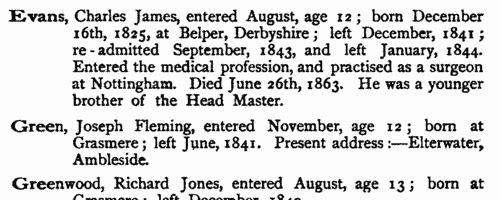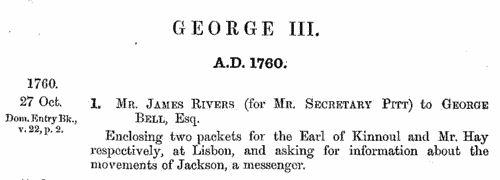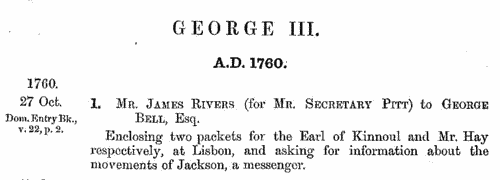Add this eBook to your basket to receive access to all 1,720 records. Our indexes include entries for the spelling forster. In the period you have requested, we have the following 1,720 records (displaying 411 to 420): These sample scans are from the original record. You will get scans of the full pages or articles where the surname you searched for has been found. Your web browser may prevent the sample windows from opening; in this case please change your browser settings to allow pop-up windows from this site.  Masters of apprentices registered at Bristol
(1759) Masters of apprentices registered at Bristol
(1759)
Apprenticeship indentures and clerks' articles were subject to a 6d or 12d per pound stamp duty: the registers of the payments usually give the master's trade, address, and occupation, and the apprentice's name, as well as details of the date and length of the apprenticeship. There are central registers for collections of the stamp duty in London, as well as returns from collectors in the provinces. These collectors generally received duty just from their own county, but sometimes from further afield. The indentures themselves can date from a year or two earlier than this return. (The sample entry shown on this scan is taken from a Bristol return. Each entry has two scans, the other being the facing page with the details of the indenture, length of service, and payment of duty.) IR 1/53 | Sample scan, click to enlarge

|  Masters of apprentices registered at Durham
(1759) Masters of apprentices registered at Durham
(1759)
Apprenticeship indentures and clerks' articles were subject to a 6d or 12d per pound stamp duty: the registers of the payments usually give the master's trade, address, and occupation, and the apprentice's name, as well as details of the date and length of the apprenticeship. There are central registers for collections of the stamp duty in London, as well as returns from collectors in the provinces. These collectors generally received duty just from their own county, but sometimes from further afield. The indentures themselves can date from a year or two earlier than this return. (The sample entry shown on this scan is taken from a Bristol return. Each entry has two scans, the other being the facing page with the details of the indenture, length of service, and payment of duty.) IR 1/53 | Sample scan, click to enlarge

|  Masters of apprentices registered at Lynn in Norfolk
(1759) Masters of apprentices registered at Lynn in Norfolk
(1759)
Apprenticeship indentures and clerks' articles were subject to a 6d or 12d per pound stamp duty: the registers of the payments usually give the master's trade, address, and occupation, and the apprentice's name, as well as details of the date and length of the apprenticeship. There are central registers for collections of the stamp duty in London, as well as returns from collectors in the provinces. These collectors generally received duty just from their own county, but sometimes from further afield. The indentures themselves can date from a year or two earlier than this return. (The sample entry shown on this scan is taken from a Bristol return. Each entry has two scans, the other being the facing page with the details of the indenture, length of service, and payment of duty.) IR 1/53 | Sample scan, click to enlarge

| Mathematics students at Cambridge University
(1759)
Tripos lists or examination results for the year, arranged by class (Wranglers, Senior Optimes and Junior Optimes), and within each class in order of score in the examination. Each student's surname and college is given: this list was printed in 1890, and was annotated with asterisks to show which students had subsequently become fellows of the university; and with footnotes showing those who became headmasters, &c., elsewhere. Recipients of the Chancellor's Medals are annotated with (A) for the senior medal, (B) for the junior. These lists are particularly useful in identifying for an individual the fellow-students who will have attended lectures with him; and, where from the college, are likely to have been even more closely associated by having been under the same supervisor. (The sample scan is from the start of the Mathematics Tripos list for 1770) | Sample scan, click to enlarge

| Parish Registers of Morden in Surrey: Burials
(1759)
The parish of Morden lay in Wallington hundred of Surrey, and in Surrey archdeaconry of the diocese of Winchester. F. Clayton prepared this transcript of the four earliest surviving registers, which was privately printed for the Parish Register Society as their 37th volume in 1901. | Sample scan, click to enlarge

| Boys entering Sedbergh School
(1745-1760)
B. Wilson prepared this edition of the register of the Grammar School at Sedbergh in the West Riding of Yorkshire, published in 1895. Sedbergh school had three exhibitions at St John's College, Cambridge, and for the earliest years little more could be found about the pupils at the school than was recorded at St John's or other colleges. In 1700-1706 the first material from Sedbergh appears, but no more than lists of surnames. From 1746 onwards full names, or surnames and initials, are found for those boys who did not continue to university. It is only from 1820 onwards that the school register starts to give detail: month of entry, age, birthplace, and month of leaving. From then onwards Wilson was able to add more and more biographical detail, except, of course, for those boys in 1895 still at the school or with their careers yet ahead of them. | Sample scan, click to enlarge

|  Masters of apprentices registered at Norwich
(1760) Masters of apprentices registered at Norwich
(1760)
Apprenticeship indentures and clerks' articles were subject to a 6d or 12d per pound stamp duty: the registers of the payments usually give the master's trade, address, and occupation, and the apprentice's name, as well as details of the date and length of the apprenticeship. There are central registers for collections of the stamp duty in London, as well as returns from collectors in the provinces. These collectors generally received duty just from their own county, but sometimes from further afield. The indentures themselves can date from a year or two earlier than this return. (The sample entry shown on this scan is taken from a Bristol return. Each entry has two scans, the other being the facing page with the details of the indenture, length of service, and payment of duty.) IR 1/53 | Sample scan, click to enlarge

| Army officers and officials
(1760-1761)
This calendar of Home Office papers was edited by Joseph Redington and published in 1878. The period covered by this index is from the accession of king George III, 25 October 1760, to 31 December 1761. The documents abstracted were a part of the great archive called the State Papers Domestic, and comprised letters to and from the Secretaries of State, and other letters; reports; memorials and petitions; and warrants of various kinds. Some repetitive material was reduced into tables. We have teased out this diverse and heterogeneous material into separate indexes for each subject. | Sample scan, click to enlarge

| Prisoners in Newgate
(1760-1761)
This calendar of Home Office papers was edited by Joseph Redington and published in 1878. The period covered by this index is from the accession of king George III, 25 October 1760, to 31 December 1761. The documents abstracted were a part of the great archive called the State Papers Domestic, and comprised letters to and from the Secretaries of State, and other letters; reports; memorials and petitions; and warrants of various kinds. Some repetitive material was reduced into tables. We have teased out this diverse and heterogeneous material into separate indexes for each subject. | Sample scan, click to enlarge

|  Apprentices registered in Colchester
(1761) Apprentices registered in Colchester
(1761)
Apprenticeship indentures and clerks' articles were subject to a 6d or 12d per pound stamp duty: the registers of the payments usually give the master's trade, address, and occupation, and the apprentice's name, as well as details of the date and length of the apprenticeship. There are central registers for collections of the stamp duty in London, as well as returns from collectors in the provinces. These collectors generally received duty just from their own county, but sometimes from further afield. The indentures themselves can date from a year or two earlier than this return. (The sample entry shown on this scan is taken from a Bristol return. Each entry has two scans, the other being the facing page with the details of the indenture, length of service, and payment of duty.) IR 1/54 | Sample scan, click to enlarge

|
Research your ancestry, family history, genealogy and one-name study by direct access to original records and archives indexed by surname.
|












